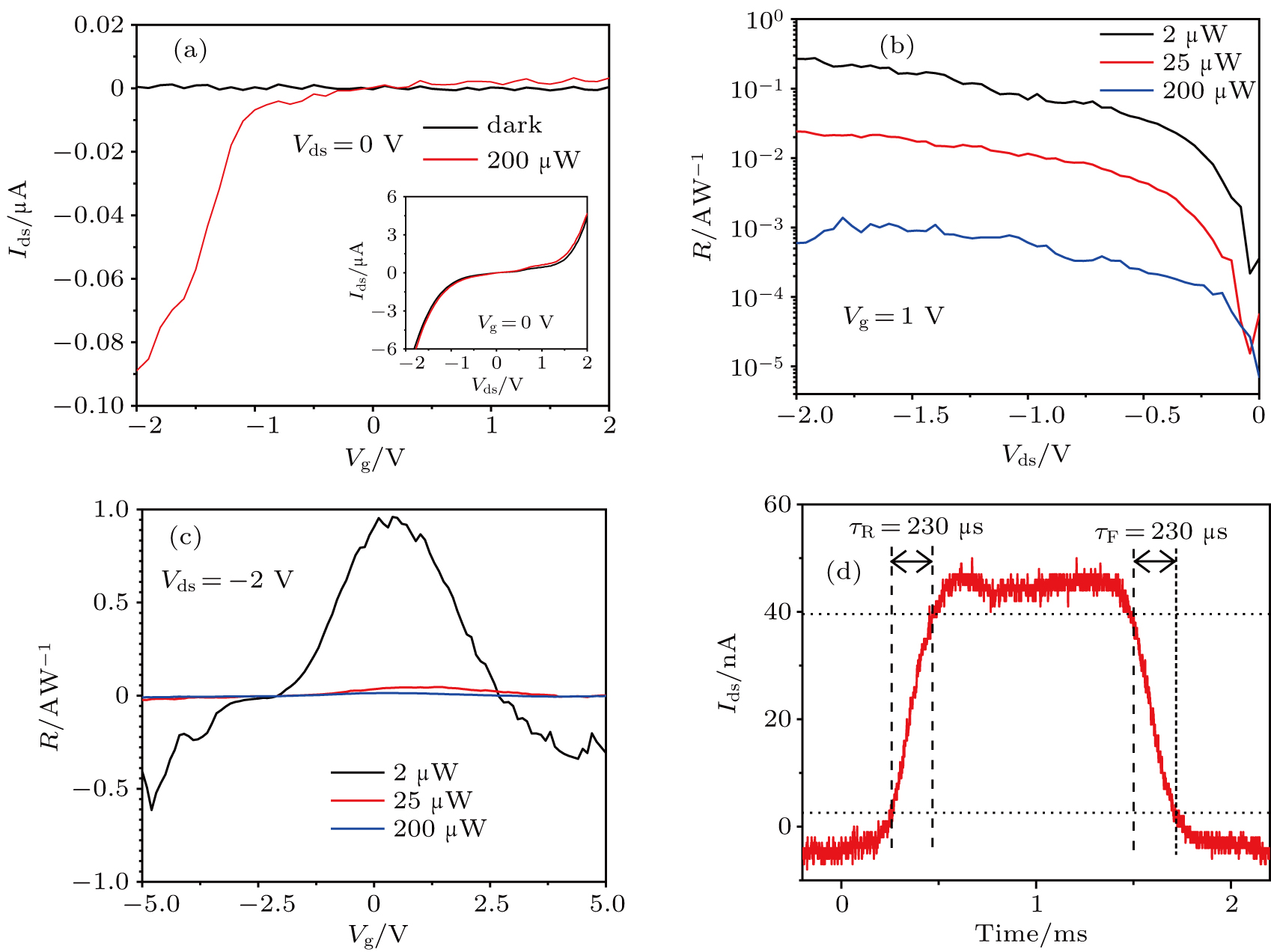† Corresponding author. E-mail:
Project supported by the National Key Research and Development Program of China (Grant Nos. 2018YFA0307200 and 2017YFA0303800), the National Natural Science Foundations of China (Grant Nos. 61522507 and 61775183), the Key Research and Development Program in Shaanxi Province of China (Grant No. 2017KJXX-12), and the Fundamental Research Funds for the Central Universities (Grant Nos. 3102017jc01001 and 3102018jcc034).
We demonstrate a reconfigurable black phosphorus electrical field transistor, which is van der Waals heterostructured with few-layer graphene and hexagonal boron nitride flakes. Varied homojunctions could be realized by controlling both source–drain and top-gate voltages. With the spatially resolved scanning photocurrent microscopy technique, photovoltaic photocurrents originated from the band-bending regions are observed, confirming nine different configurations for each set of fixed voltages. In addition, as a phototransistor, high responsivity (∼ 800 mA/W) and fast response speed (∼ 230 μs) are obtained from the device. The reconfigurable van der Waals heterostructured transistors may offer a promising structure towards electrically tunable black phosphorus-based optoelectronic devices.
Two-dimensional (2D) materials rose sharply after the exfoliation of graphene in 2004.[1–3] A large number of 2D materials ranging from semimetal to semiconductor and to insulator have been investigated,[4–6] and some of them are considered as promising next-generation constituents in optoelectronic circuitry.[7–9] Graphene was once a good choice for optoelectronic applications due to the broad band absorption and high carrier mobility (in the order of 104 cm2·V–1·s-1). However, the absence of bandgap makes graphene only a good 2D electrode due to the low absorbance and bad current on/off ratio. For a single device such as a field-effect transistor (FET), the high mobility channel materials with moderate bandgap are desired.
Black phosphorus (BP) with a monolayer thickness of ∼ 0.53 nm recently emerges as a good candidate for 2D material-based optoelectronics.[10] Its direct bandgap could be varied from 0.3 eV to 1.3 eV by reducing the layer number to monolayer gradually.[11] This bandgap leads to a very good current on/off ratios (up to 105) in the FET, which is superior to the gapless graphene. The carrier mobility of few-layer BP, in the order of 102 cm2·V–1·s–1 at room temperature,[12] is higher than those in most of the 2D semiconductors, such as transition-metal dichalcogenides. In addition, BP’s ambipolarity promises it to be a good channel material for constructing electrostatically tuned optoelectronic devices.[11–17] The limitation for BP devices is mainly the bad air-stability, which fortunately could be overcome from encapsulation by other transparent insulators.[18] Hexagonal boron nitride (h-BN) is such a 2D insulator with a large bandgap (> 5 eV), which is also suitable as a gate dielectric material.[4,6,19] Combining 2D materials with different electronic properties ranging from semimetal e.g., graphene) to semiconducting e.g., BP) and to insulating e.g., h-BN), one could fabricate various electronic and optoelectronic devices by simple van der Waals contact with flat surfaces and disorder-free interfaces.
Here, we present the achievement of a reconfigurable BP FET, which is van der Waals heterostructured with graphene and h-BN. A few-layer BP channel is in contact with source-drain graphene electrodes and covered by a top h-BN dielectric layer. Another graphene sheet on the top of h-BN acts as the top-gate electrode. Nine different configurations of the homojunction over the BP channel are achieved by controlling both the drain-source voltages and gate voltages. The applied voltages are less than 2 V. All configurations can be spatially visualized and confirmed by scanning photocurrent microscopy (SPCM). Meanwhile, the phototransistor has a high responsivity (up to 800 mA/W) and a fast response speed (∼ 230 μs), offering potential applications towards photodetection and energy harvesting based on few-layer BP.
Figure 

A typical electrical transfer characteristic of the fabricated BP top-gate transistor is shown in Fig.
Figure
The asymmetric property of Fig.
In the fabricated heterostructued BP device, photocurrent would generate at the band bending region via the photovoltaic effect. The spatially resolved SPCM technique is therefore a good way to visualize the device configuration. Figure
To explain the photocurrent maps, we draw the simplified band diagram according to the analysis in Fig.
To investigate the photoresponse of our BP-based transistor, photocurrent measurements are carried out at a BP-graphene contact. Figure
In summary, we have fabricated a van der Waals heterostructured top-gate transistor with all 2D constituents (including BP, graphene, and h-BN layers). By applying less than 2 V of both top-gate and source–drain voltages, this device has been reconfigured successfully by utilizing the ambipolar tunable characteristics of BP channel, where nine different configurations have been realized. By spatially resolved scanning photocurrent microscopy technique, all configurations were directly visualized, and the photocurrent was only detected at the contact regions where band bending occurred. In addition, high responsivity and fast photoresponse speed have been observed in the devices, assuring the potential ability in photodetection. Consequently, our reconfigurable heterostructured BP transistors may offer a potential useful structure towards electrically tunable photovoltaic devices.
| [1] | |
| [2] | |
| [3] | |
| [4] | |
| [5] | |
| [6] | |
| [7] | |
| [8] | |
| [9] | |
| [10] | |
| [11] | |
| [12] | |
| [13] | |
| [14] | |
| [15] | |
| [16] | |
| [17] | |
| [18] | |
| [19] | |
| [20] | |
| [21] | |
| [22] | |
| [23] | |
| [24] | |
| [25] | |
| [26] | |
| [27] | |
| [28] | |
| [29] | |
| [30] |






